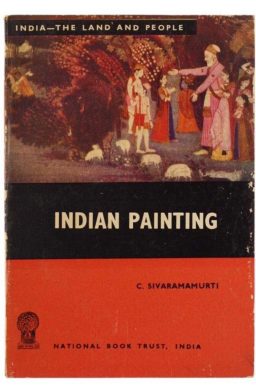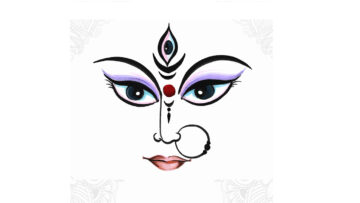To capture the spirit, history, style and masterpieces of any of the various Indian arts, in a mere span of one hundred pages is a challenging, perhaps even intimidating task, but padma bhushana C. Sivaramamurti beautifully accomplishes exactly this in his book Indian Painting. Despite the vastness of the subject, the book is one of the definitive introductory works on Indian paintings, highlighting their salient features, beauty, significance, and continuity across centuries of Indian history.
The author, an internationally renowned scholar, whose entire life was dedicated to the study of Indian heritage, adorned with numerous prestigious positions and chairs during his illustrious career spanning several decades (until his demise in 1983), takes us on a brief but immersive excursion on Indian paintings, beginning from their prehistoric origins to their golden age under Gupta and Vijayanagara era, up until the influence of European styles in the nineteenth century.
The earliest paintings in India, like in any other part of the world, are from the pre-historic era and primarily depict hunting scenes or encounters with animals. These paintings, with humans drawn as stick figures carrying spears and javelins, have an affinity with the primitive paintings of Gogul in Spain. Readers may also note the similarity here with the famous prehistoric cave paintings in Chauvet, France.
While focused on the origin of paintings, we inevitably learn about the role of art in general, and paintings in particular, in Indian life. No aspect of Indian life was devoid of art and, as one can see this even today—especially in the rural areas—even mundane objects carried patterns, designs or engravings on them. The book brings out the artistic and thematic continuity in Indian paintings across the Spatio-temporal expanse of India. The themes, style, and motifs painted in the Gupta and Satavahana period recur and influence the later works across Indian geography: from Chalukyas to Vakatakas, Pallavas, Cholas, and Hoysalas in the South; from Palas in the East to the Rajasthanis in the West.
Depending on the dynasty and the influential school of thought of the era, the paintings variously depict Jataka tales (most prominently in Ajanta); Buddha’s various forms or the pan-Indian motifs from the Mahabharata, Ramayana, Krishna and Rama lilas. Though the motifs primarily focused on the lilas of principal deities or in many cases, of the princes and kings—whose glory and qualities the painters chose to highlight—the secondary characters are drawn in the background such as the ganas, chauri bearers, flute, drum or cymbal players, etc. were also given their due with incredibly subtlety. However, it was not only the court scenes or the chosen deities, but also nature, plants and animals which were among the greatest sources of inspiration for Indian painters, and they were painted along with the principal subjects or even themselves as a subject.
The savant throws light on that nearly ubiquitous trait of Indian art (and of many other Indian disciplines as well), also prevalent among painters, that of subsuming the artist in the background while elevating the art to become a tribute to the divine – the reason why we do not know the names of many painters. Indeed, as the author describes, the final brush strokes (usually the painting of eyes of the figures) in a painting are considered akin to prana pratishtha in a temple and was done with a similar ritual solemnity among the guild of painters.
Painters generally enjoyed a special place among artists and were greatly respected in ancient India. An astute painter could draw a hermit, a couple in loving embrace, a busy street bustling with economic activity or a scene of battle, with equal ease. One of the most captivating and highly praised qualities among painters was the ability to draw murals that depict the fusion of various rasas in a single panel. Given that the Indian paintings (to an extent like Chinese or Japanese paintings) were considered a reflection of the physical and mental states of the painter, this ability to bring forth the “commingling of rasas” inform us about the deep commitment, dexterity, and immersion of painters in their work. The magnificent Tripurantaka painting depicting vir, santa, raudra, vismaya, adbhuta, hasya and karuna rasas together is an outstanding example of the painter’s skill in fusing emotions. And not only skills, painters also had the humility and maturity to anticipate and invite criticism. How singularly the artists committed themselves to their work in India can be understood by the desire of a king to become one of them, as noted in the below quote by Dr. Sivaramamurti:
“If the ivory carvers of Vidisha, who practiced different mediums, could carve in stone as easily as they could paint with a brush and produce the Sanchi gateway, it is no wonder that a king on his elephant, who approached an ivory carver at work, covered all over with ivory dust, lost in his own work, unconscious even of the presence of the ruler so close to him, as given in early Buddhist texts, longed very much indeed that he himself was just a wonderful creative carver in ivory rather than the ruler in his dazzling palace that he was.”
It goes without saying that a culture with such a degree of refinement in paintings (or arts in general) could not have been without some platform for public display of paintings and here too ancient India speaks to us, as the gifted author notes, via its various art galleries – public, private and palace. Each of them displayed a specific type of paintings; however, in general, preference was always given to auspicious themes. There are even mentions of caravan-like mobile art galleries which would traverse the region displaying the works of various painters.
The book provides several nuggets on how advanced the art critique in India was, with a number of texts dedicated to the subject. To take a very shallow dip in it, consider this:
“Minute details as even the shape of hair like kuntala, dakshinavarta, aranga, simhakesara, etc., the measurement of limbs in general according to the tala proportions, different shape of eyes like chapakara, matsyodara, utpalapatrabha, etc., poses or sthanas like rijvagata, ardharju, etc., different methods of foreshortening or kshayavriddhi, the methods of shading like patra, raikhika, binduja, the modes of representing a variety of subjects chosen for delineation like kings, courtiers, courtesans, warriors, animals, rivers, etc., and several other art themes, which compose detailed canons of art criticism are discussed in the chitrasutra of the Vishnudharmottara, which was an accepted textbook for artists and sculptors and nagarakas for a good general equipment in fine arts. It also shows that ancient India could boast of a highly evolved science of art criticism.”
Art canons emphasize on the sublime and subtle as being superior to immodest decoration and loud colors, and cite a lot of examples such as the ability to depict the distinction between a sleeping and a dead figure, portrayal of minute details in the background, depict various states and emotions like inebriation, mystical smiles, intelligence, virginity and so on. Line sketches, when drawn gracefully and firmly, were considered among the highest achievements. However, the readers may be surprised to learn from Dr. Sivaramamurti that the general Sanskrit literature, if studied carefully, has more to reveal about paintings and art than the specific texts themselves!
One of the many reasons for such tremendous development and refinement of painting was the involvement of Indian royalties and elites, who not only supported the art monetarily, but were themselves well versed in its nuances. Some of the greatest rulers of India—like Narasimhavaramana, Pulakesin, Harsha, Vikramaditya and many others—were also among the greatest patronizers of Indian art, and the author educates us about all the illustrious princes and kings who have throughout Indian history patronized poetry, architecture, sculpture and certainly, paintings. Indeed a great connoisseur of art like the Pallava king Mahendravarmana bore many titles such as Vichitrachitta, Chitrakarapuli, Mattavilasa, Chaityakari and so on. Dynasties or the kings (or the royal couple) were often devoted to a particular deity and commissioned artists to paint themes dear to them. For example, the emblem of Chalukyas was a varaha, highlighting the notion of Chalukyan kings’ hold over their vast empire, just like the varaha which bore the burden of earth with ease; or the opulent Tripurantaka and Nataraja paintings which depict the devotion of Cholas, their military spirit and spiritual ideals.
In a rather compact book, Dr. Sivaramamurti deftly provides us multiple examples of certain lesser known but unique qualities of Indian paintings. Let us take one of them – to an untrained eye, the illustrations provided along with a text may appear to be just another instance of Indian paintings, but here Dr. Sivaramamurti illuminates his reader about their uniqueness viz. the Indian paintings are primarily murals and whenever seen along with a text (as an illustration), they are actually smaller size miniatures of original wall paintings. This difference, among many others, makes them stand apart from other styles of paintings, for example, like the Persian illustrations which are integral part of the textual material.
The reader will notice that even in a book specifically written on the subject of paintings, the deeply intertwined nature of various Indian disciplines, vocations and crafts like dance, music, drama, sculpting, poetry, architecture, philosophy and social life, is easily evident – a fact which only re-confirms that Indian society did not consider any aspect of life as totally secluded or in isolation from the rest. The refinement and development of one art brought forth a corresponding development in another (for example, progress in sculpting is seen closely correlated with progress in paintings). There were hardly any aspects of Indian life which were devoid of paintings and they even find a spot in bedrooms, where Kamadeva held a special place. We thus learn about the degree of importance ancient India placed on auspiciousness, pleasure and the joy of life – a quality contemporary India, especially in its public and civic life, can learn a lot from.
Dr. Sivaramamurti while educating us, does not let the subject become dry and has infused his book with many interesting anecdotes, short stories, and facts, such as: the case of dindins (or assistant painters; usually employed for renovation) who would almost always ruin the original, unless guided by the accomplished chitracharyas; painters being called the kalachoras, ‘thieves of time’, since they take a great amount of it in completing their work but always expect to be paid on time nevertheless; plentiful Jataka tales from a Buddhist tradition; the notion of a righteous ruler sharing the throne of Indra with his consort, as seen in the Badami cave painting of Chalukya king Kirtivarmana; the immense significance of Rajendra Chola’s desire to seek only the water of Ganges from the vanquished Northern kings; the fact that every citizen of taste cultivated an interest in painting and had at least the basic tools of the craft in his house and so on. Perhaps no work on Indian art can ever be complete without referring to the awe-inspiring Bhrihadeeshwara and Kailasnatha temples, and they do find a mention here as well.
The learned author also delineates on occasional foreign influences on Indian paintings. Over the course of history, foreign artistic influences inevitably seeped into the indigenous art—such as during the Kushana, Pandya and later in the Mughal and European period—leading to a fusion of the two, but with time, we observe that the indigenous style effaces the foreign influence to re-assert itself. However, there are cases, such as the Pahari paintings—which were patronized by the Rajputs in the hilly areas, away from the attention of Mughal rulers—where the native style remained uninfluenced by foreign forces. Stepping into the modern era, the author points out the impact of European styles which was most noticeably seen in the work of Raja Ravi Varma. However, the Bengal school realized it soon that European influences will unmoor the Indian artists, and painters from this school made great strides in re-capturing the spirit of Indian painters of the yore.
The doyen also brings forth the immense effort put in for preservation and discovery of Indian paintings by modern scholars and painters—both Indian and non-Indians—such as Asit Kumar Haldar, Nandalal Bose, Stella Kramrisch, Dr. Jouveau Dobreuil, SK Govindaswami, and numerous others. Dr. Sivaramamurti’s Indian Painting also contains copious amounts of notes and bibliography for anyone interested in gaining depth and nuance in this thoroughly enjoyable, exhaustive, and riveting subject. The book also provides various colored, black and white and sketched plates for a better understanding of paintings under discussion.
As noted earlier, while the subject of the book is painting, it is in reality a kaleidoscope of various aspects of art and life—which were unbreakably intermingled—in ancient India, which makes it a very engaging read.
Disclaimer: The opinions expressed in this article belong to the author. Indic Today is neither responsible nor liable for the accuracy, completeness, suitability, or validity of any information in the article.








